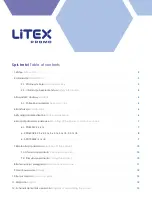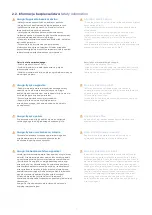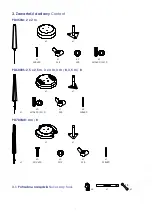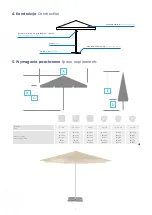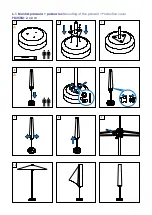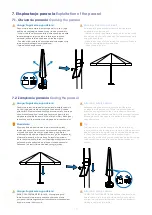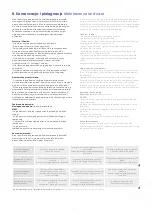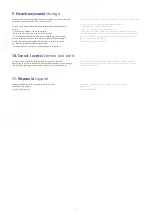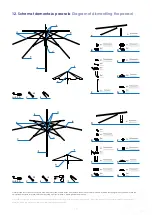
4
- Należy stawiać parasol tylko na stabilnym podłożu
i w oryginalnych podstawach do tego przeznaczonych.
- Należy zawsze mieć pewność, że maszt jest solidnie
zamocowany do podstawy parasola.
- Należy zawsze zamknąć parasol przeciwsłoneczny
i zakładać osłonę w przypadku, gdy wzrośnie umiarkowany
wiatr, nadejdą opady deszczu lub śniegu.
- Nie należy zawieszać żadnych przedmiotów (np. ubrań) na
ramionach parasola.
- Parasol nie jest przystosowany do eksploatacji
w warunkach obciążenia śniegiem. W takim przypadku
parasol bezwzględnie musi zostać zamknięty i spięty opaską
zabezpieczającą przed samoczynnym otwarciem.
- Przed otwarciem parasola przeciwsłonecznego należy
upewnić się, że nie ma osób znajdujących się w jego
pobliżu, a przed zamknięciem należy upewnić się, że nie ma
osób znajdujących się pod parasolem.
- Parasol przeciwsłoneczny nie jest zabawką.
- Upewnij się, że dzieci nie używają parasola
przeciwsłonecznego, jako pola do zabawy lub obiektu
do wspinaczki.
Pod parasolem lub w jego pobliżu nie wolno korzystać
z otwartego ognia np. ogrodowego barbecue, grilla.
Czynności naprawcze związane z parasolem mogą być
przeprowadzane tylko przez osobę kompetentną
do używania wymaganych narzędzi.
Łatwiej jest zamontować parasol przy pomocy drugiej osoby
dorosłej. Przed przystąpieniem do montażu należy upewnić
się, że stała podstawa parasola jest pewnie zamontowana
i stoi stabilnie. Ze względu na wagę podstawy powinny ją
przenosić min. trzy dorosłe osoby. Po ustawieniu podstawy
należy włożyć parasol w nasadę podstawy i zabezpieczyć
przez przełożenie i skręcenie śruby imbusowej za pomocą
nakrętki samokontrującej. Śrubę należy dokręcić tak mocno
aby nie można było odkręcić jej bez użycia narzędzi.
W trakcie eksploatacji użytkownik musi sprawdzać /
kontrolować dokręcenie śrub zarówno podstawy, jak i nasady
z parasolem.
Uwaga: Do skręcenia śruby należy stosować wyłącznie
nakrętkę samokontrującą.
Opis siły wiatru umiarkowanego:
- Wiatr o prędkości około 7,9 m/s.
- Skutki na lądzie: kurz i papier podnoszą się, gałęzie
zaczynają się ruszać.
- Skutki na wodzie: małe fale, na których grzbietach tworzy się
piana, słychać plusk.
- Place the parasol only on a stable surface and in the original
bases designed for it.
- Always ensure that the mast is firmly attached to the base
of the parasol.
- Always close the sunshade and put the cover on when
moderate winds increase or rain or snow comes.
- Do not hang any objects (e.g. clothes) on the arms of the
parasol.
- The parasol is not suitable for use under snow load. In this
case the parasol must absolutely be closed and fastened with
a band to prevent it from opening by itself.
- Before opening the sunshade, make sure there are
no people around and before closing it, make sure there are
no people under the sunshade.
- A sun parasol is not a toy.
- Make sure that children do not use the sunshade as a play
area or climbing object.
No open fires, e.g. garden barbecues or barbecues, are
allowed under or near the parasol.
Repair work on the parasol must only be carried out
by a person competent to use the required tools.
It is easier to install a parasol with the second adult’s help.
Before installing make sure that core parasol base is safely
mounted and stable. Due to the weight of the base, it should
be transported by min. three adults. After setting the base, put
the parasol into the base tube and secure by inserting and
twisting the allen screw with self-locking nut. The screw should
be tightened so much that it can not be unscrewed without
the use of tools. During exploitation, the user must check
/ control the tightening of the base screws and the screw
connecting the base tube and the pole of the parasol.
Note: Twisting the allen screw should be done only by using
a self-locking nut.
Description of moderate wind strength:
- Winds of approximately 7.9 m/s.
- Effects on land: dust and paper rise, branches start to move.
- Effects on water: small waves on whose crests foam forms,
splashing can be heard.
2.2. Informacje bezpieczeństwa
Safety information
Attention: Safety hazard
Warning: Risk of accident
Caution: Risk of fire
Note: Risk of damage to health
Warning: Risk of an accident!
Uwaga: Zagrożenie bezpieczeństwa
Uwaga: Ryzyko wypadku
Uwaga: Ryzyko pożaru
Uwaga: Ryzyko uszczerbku na zdrowiu
Uwaga: Niebezpieczeństwo wypadku!



